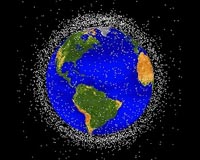 |
Guildford, UK (SPX) Nov 12, 2010 Surrey Satellite Technology Ltd (SSTL) has successfully repositioned the UK-DMC-1 spacecraft, which is reaching the end of its operational life, using unspent propellant to reduce the orbital lifetime and the probability of generating space debris. Since the first satellite, Sputnik 1, was launched in 1957, thousands of satellites, launch vehicles and probes have been sent into space. In fact, it is estimated that there are more than half a million pieces of debris larger than a centimetre currently orbiting the Earth and the problem can only grow as existing satellites age and more are launched. NASA has replaced windows on the space shuttle and the International Space Station (ISS) has been repositioned after a near-miss event. Even the smallest object, such as a bolt or a speck of paint can cause critical damage to a spacecraft when travelling at speeds of up to 25,000 mph and the practice of predicting potential collisions and manoeuvring to avoid them is increasing within the satellite community. UK-DMC-1's manoeuvres were designed to deplete the remaining butane from the propellant tanks in the spirit of industry best practice regarding orbital debris. Depletion of the propellant ensures that there are no on-board pressure sources which could cause the spacecraft to break-up and increase the space debris population. These manoeuvres have also brought the satellite closer to Earth, and thereby reduced the time until atmospheric re-entry by more than 100 years reducing the probability of orbital collisions in the future. From its operational headquarters in Guildford, UK, SSTL's Spacecraft Operations team executed a series of precisely planned manoeuvres during a 2 week period in September. The spacecraft's perigee (the closest point to the Earth during its orbit) was reduced from the operational altitude of 675.4km to 596.9km. Prof Richard Crowther of the UK Space Agency commented "The UK Space Agency welcomes the news that SSTL has successfully reduced the altitude of UK DMC-1 and therefore its remaining lifetime in orbit. Such best practice to minimise collision risk to the remaining orbital population should be followed by all responsible operators and SSTL should be congratulated for what is an exemplary mission." Since its launch in September 2003, the SSTL-built satellite has achieved all of its mission objectives and remains in good condition well beyond its design life of 5 years and is still acquiring images for SSTL's remote sensing subsidiary DMCii. UK-DMC-1 was part of the Disaster Monitoring Constellation and carries a first generation medium resolution 32m Ground Sample Distance (GSD) multi-spectral imager. When launched, the 89kg spacecraft carried a small butane propulsion system which contained 2.35kg of propellant, the primary function of which was to perform orbit maintenance and constellation management. When the spacecraft was no longer required to be maintained in the constellation, all of the remaining propellant was then used to perform the orbit lowering manoeuvres.
Share This Article With Planet Earth
Related Links Surrey Satellite Technology Limited (SSTL) Space Technology News - Applications and Research
 The GEO Graveyard May Not Be Permanent
The GEO Graveyard May Not Be PermanentBethesda MD (SPX) Nov 09, 2010 Since the 1970s, a number of geostationary satellites have been placed in the so called "graveyard orbit," an orbit just above the GEO altitude, roughly 100 to 300 km. The sole purpose of this "burial" location is to remove expired satellites from the highly-congested GEO ring about the equator. Although most GEO satellite operators have not taken advantage of removing their old spacecraft ... read more |
|
| The content herein, unless otherwise known to be public domain, are Copyright 1995-2010 - SpaceDaily. AFP and UPI Wire Stories are copyright Agence France-Presse and United Press International. ESA Portal Reports are copyright European Space Agency. All NASA sourced material is public domain. Additional copyrights may apply in whole or part to other bona fide parties. Advertising does not imply endorsement,agreement or approval of any opinions, statements or information provided by SpaceDaily on any Web page published or hosted by SpaceDaily. Privacy Statement |